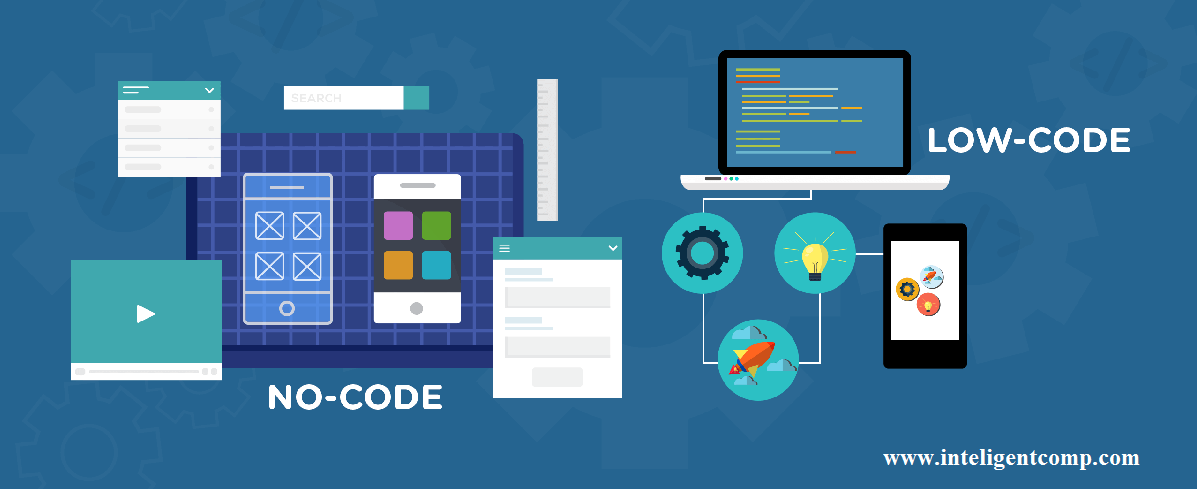In recent times, there has been a flurry of activity around platforms that are offering people to create applications with little or no development experience as well as still creating professional applications with required features in an extremely tight timeframe. This new generation of Low code No code platforms are designed to design, build, and launch applications quickly, without having to worry about the details of background operating systems or scalability requirements.
What do Low-code and No-code Development mean?
Low-code/no-code development platforms are types of software development environments that use a visual approach to software development. It allows enterprise developers and citizen developers to create an application by drag and drop application components, connect them together and create mobile or web apps. This approach lets professional developers quickly build and release applications without having to write code line by line.
How do Low-code and no-code development works?
In traditional software development, professional programmers create desired functions and features of the software by writing lines of codes. This process requires programmers to have in-depth knowledge of programming languages, development environments, deployment processes, and testing protocols.
Low-code and no-code platforms encapsulate all that work behind the scenes. People who have no knowledge of traditional programming language can visually select and connect reusable components (made blocks of pre-defined code having particular features), and link them together to rapidly create a customized software application with the desired workflow. It also cost much lower than hiring a professional programmer.
Use Cases of Low code No code Platforms in Software Development
Low-code platforms support apps for various business or technical purposes which do not require complex programming and need very little or no customization. Application created using these platforms handle more use-cases due to their general-purpose nature, including:
- Innovative use cases with next-generation technologies. Many low-code platforms not only come with a very comprehensive component library built by technology leaders, but also enable you to have access benefits from third-party smart services offered in the cloud, such as AI, machine learning, blockchain, and voice and facial recognition services, as well as tools available via the open-source community.
- Customer experience applications that use pre-built user-interface templates integrated with user-friendly design mobile-friendly Interface, while also staying consistent with corporate branding of an organization that uses it.
- Productivity and operational efficiency apps aimed at operational efficiencies, such as computerizing manual and paper-based processes spanning across departments and domains
- Modernize legacy systems helping organizations advance their digital transformation using component-based development using containers, and continuous deployment opportunities for existing mission-critical applications.
- Business apps that are used by workers, as well as apps used by business partners. They can also be good choices for creating customer engagement apps.
Here are some leading vendors with low-and no-code offerings:
Salesforce
The Salesforce Platform is an all-business platform. It offers a number of business products range of tools designed to help business-side application development, including Salesforce Lightning, Force.com, and the Cloud Platform Salesforce App.
OutSystems
OutSystems supports an AI-enhanced development platform. It is offering a solution that employs AI to help developers build applications through a visual, model-driven development environment.
Microsoft Power Apps
Microsoft Power Apps are the primary Microsoft low code and no-code development platform. This is designed to help users create rich web and mobile applications.
Appian
The Appian offers a low-code automation platform with a visual interface and pre-built development module. Appian low code automation platform provides a unified environment aiming to automate complex business processes including robotic process automation, business process management, case management, artificial intelligence, and decision rules.
ServiceNow
Service Now was Originally targeted at IT operations management and services. The company now also develops a cloud computing platform to help companies manage digital workflows for enterprise operations.
Advantages of Low code No code Platforms
First and foremost, Low code no code platforms speed the development and delivery of applications — a critical element in the digital age when organizations must race to meet worker and customer demands, or be disrupted by others who do so.
These platforms also give problem-solving capabilities into the hands of non-IT professionals, allowing everyday workers to easily create business apps that help them do their business and jobs.
These platforms also free professional developers from mundane and repetitive programming activities. Professional Developers can use these platforms to quickly create apps for basic functions and then tweak them to add more valuable features to them.
These platforms also allow Programmers to spend more time developing custom apps that require more flexibility and Give more time to initiatives that need complex programming adding value to their organizations.
Limitations of using Low code No code platforms
Low-code and no-code platforms, of course, have their limits. Software engineers see these tools as an extension of methods they already practice, like using pre-built frameworks or Javascript libraries, rather than a straight replacement of their work. May experts suggest that No-code are useful to help small businesses with some digital operations, but they are not enough to provide you all kinds of feature and solutions.
Advanced and complex applications will always require a professional programmer’s skills. The custom-built application provides more customization flexibility and greater control over features of the application, which is not possible through low-code/no-code platforms.
While low-code/no-code platforms can help with the speed of development and allocation of resources, it restricts customization of digital resources, has very limited integration with existing core digital infrastructure. It remains heavily dependent on the low-code and no-code vendors or platforms for configuration and delivering changed requirements.
Where low-code and no-code platforms might make the biggest difference is rather with businesses that have no legacy technology, and are starting from a clean slate like start-ups and small companies with new business ideas. Where would-be entrepreneurs looking quickly implement their small business ideas instead of spend time on technical details and application development process.
Are low-code and no-code platforms going to replace Programmers?
As enticing as the prospect may sound to small companies with restricted budgets, the trend is also seen as a threat to programmers. More money spent on automated coding platforms, after all, means that less investment will go towards hiring human developers.
But while the profession might go through some change, it is far from the risk of disappearing. In the future, it seems possible that we will have either developer that is good at low-code, with basic engineering skills, and are good at solving problems by using the existing tools that are there. And on the other extreme, we’ll have specialist programmers working on those reusable components to be used by non-programmers.
According to Industries experts, Sophisticated and complex applications will always require a professional programmer’s skills. For that reason, medium and larger enterprises will continue to go for custom-built applications that offer more flexibility and customization options.
Even if non-developers become good at using Lego blocks of code to build applications, a degree of programming will still be required to create those blocks anyway. Human Programmers will also be needed for higher levels of sophistication, even when using low-code tools.

